Essentially harmless, these tiny creatures can still become an issue if left unchecked. Read our black beetles guide to learn what you can do to avoid a black beetle infestation.
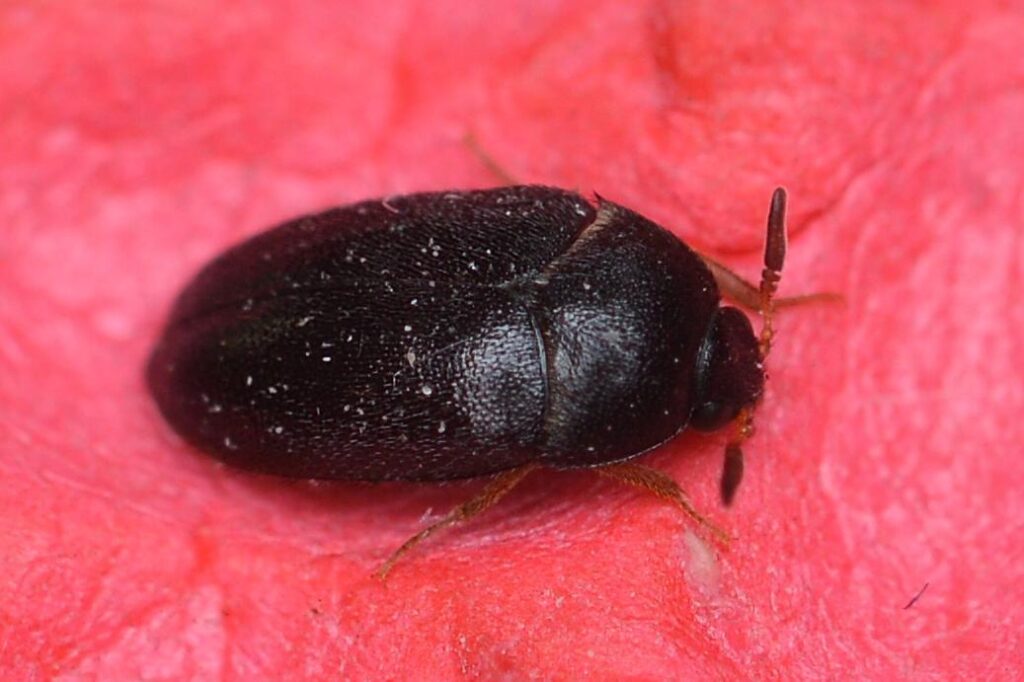
A black carpet beetle: the most common and most destructive type of carpet beetle in the United States
Let’s be honest, black beetles are like those guests that no one wants, but everyone has! These insects are in your kitchen, bathroom, garden, carpets, and some of them might even be lurking in your bedsheets. Like all other insects, black beetles are attracted to food, trash areas, dirty grills, and outdoor lighting.
Black beetles are generally considered beneficial insects. They keep the populations of other insect species in check. Also, most types of black beetles are harmless and usually nothing more than just a nuisance. However, if their populations are left unchecked, they can still become a severe household pest problem.
Black beetle larvae are in some cases more harmful and damaging than the adult stages. For instance, if present, the black carpet beetle larvae can ruin the upholstery in your home. It usually damages household items containing keratin. However, the larvae might also attack fabrics made of plant material and synthetic fiber.
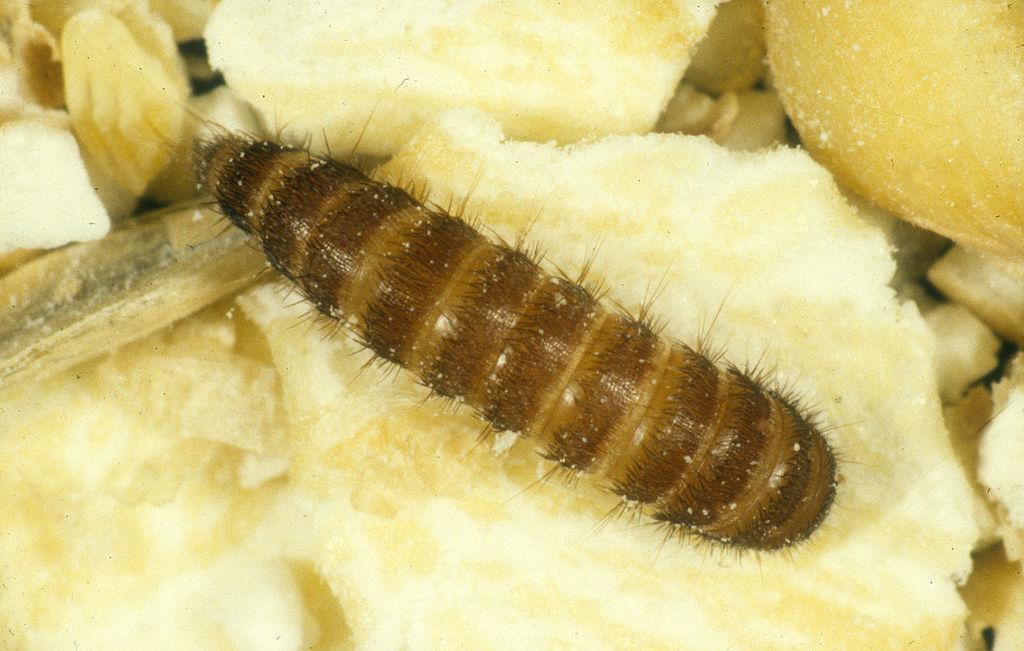
Black carpet beetle larvae are dark brown with yellow stripes and stiff hairs on their bodies
To get rid of a current infestation caused by black beetles, you will first need to identify the species you are dealing with. People commonly refer to black beetles as bugs. However, black beetles are not actually bugs. In fact, beetles and bugs are quite different from each other. A fact that is summarized in the table below:
Beetles Vs. Bugs
| Beetles | Bugs |
| They belong to the order Coleoptera of insects | They belong to the order Hemiptera of insects |
| They have chewing mouthparts | They have needle-like piercing mouthparts designed for sucking |
| They feed on both animals and plants | Most feed on plants |
| Beetles undergo complete metamorphosis | Bugs undergo incomplete metamorphosis |
| Their forewings are modified to make a hard, leathery covering called elytra | Their wings, if present, are membranous and sometimes partially thickened |
| Common examples: Leaf beetles, weevils, stink beetles | Common examples: Stink bugs, aphids, hoppers |
There are around 350,000 described species of beetles, with many more still undiscovered. There are approximately 30,000 types of beetles present in the United States alone. However, don’t be afraid! Despite having chewing mouthparts, beetles do not bite unless they have to. They only become aggressive when threatened or cornered.
Nevertheless, beetle pests are still very much a problem many people have to deal with. So, keep reading our guide. We will tell you everything you need to know about identifying different beetle types and the best pest control practices. Happy reading!
Types Of black beetles
As already stated, thousands of black beetle species are present on earth, with hundreds of beetle species being black. In this guide, we will only discuss the types that you are most likely to come in contact with. Most of these insects are oval-shaped and dark brown or black. So, you might also need to study their behavior from time to time to pinpoint the species you are dealing with. So, let’s dive right in!
1. Black Carpet Beetles
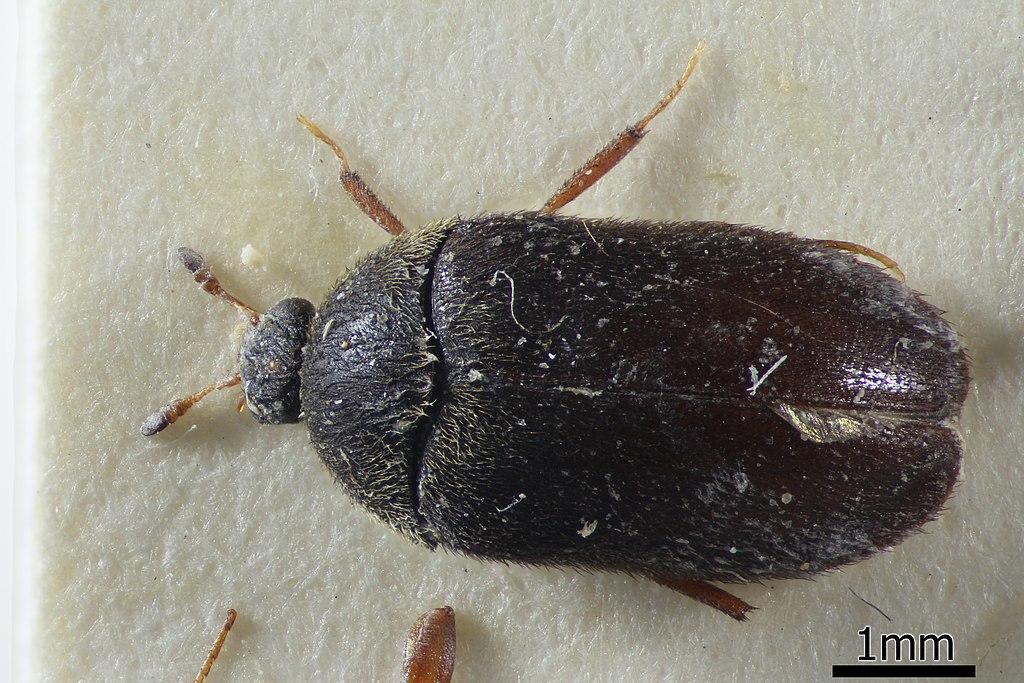
Black carpet beetles are a common pest in the American households
Black carpet beetles are common pests in warehouses, homes, and museums. They can cause severe damage to carpets, fabrics, and stored food items such as stored grain. Black carpet beetles leave holes in fabrics similar to the holes left by the moths. They can also damage furniture and carpeting as well.
Black carpet beetles are very proliferative. Female black carpet beetles lay eggs that hatch just after six to ten days. When these eggs hatch, armies of black carpet beetles emerge. These larvae then turn into adult black carpet beetles after some time. Adult beetles are usually not as damaging as the larval stage. They feed on pollen and do not cause damage to fabrics and other woolens. However, it is still better to keep their numbers in check.
Getting rid of a black carpet beetle problem is not the easiest thing to do. A black carpet beetle larva can stay dormant for up to three years and turn into an adult black carpet beetle when the conditions become favorable. The key to controlling black carpet beetles is to cut them off from their food sources which sometimes even include dead insects.
Humidity plays a vital role in their development. In the southern states, high humidity may cause their eggs to become moldy, while in the northern states, lower humidity is usually favorable for hatching
Black Carpet Beetle Quick Facts And Identification Guide
| Scientific name | Attagenus unicolor |
| Size (average) | – 3 to 5 mm in length – Larvae are around 7 mm in length |
| Color | Reddish-brown to black |
| Body features | – Oval body shape – Short, inconspicuous antennae on their head – Body is covered with short, sparse pubescence – Forelegs are much shorter than the hindlegs – Bended heads giving them a hunchbacked appearance |
| Flying | Yes |
| Range and Habitat | – Found throughout the world – Common in the United States, Canada, Mexico, and Europe |
2. Common Furniture Beetles

Photo Credit A common furniture beetle has a brown to a black body covered in rounded pits
Also known as the common house borer, these beetles are one of the most annoying wood-eating pests in the world. There are many other species of wood-boring beetles, the larval stages of which are commonly known as woodworms. Females usually lay eggs to overwinter in trees or woods. Furniture infested with furniture beetles has numerous irregular holes.
These beetles attack almost all wood types. However, furniture, paneling, and floorboards are particularly at risk. These gruesome wooden pests can also ruin the wooden structure of your homes. Their larvae can spend years munching on the wood before reaching the pupal stage and turning into adult beetles that bore their way out of the wood.
Preventing furniture beetle infestation is not always possible. This is because the larva hides deep inside the wood out of sight. However, you can reduce the chances of infestation by sealing exposed wood surfaces with paint or varnish. This will also reduce the egg-laying activities of these beetles. In addition to that, reducing moisture levels can also help prevent wood-boring beetle infestations.
Common Furniture Beetle Quick Facts And Identification Guide
| Scientific name | Anobium punctatum |
| Size (average) | – 3 to 7 mm long – Larva is 1 mm long when born and can grow as big as 7 mm near pupation |
| Color | – Larva is creamy white – Adults are generally dark brown to black |
| Body features | – Pill-shaped black body – The thorax partially obscures the head – Wings have rounded pits |
| Flying | Yes |
| Range and Habitat | – Originated in Europe, now spread through most of the world – Particularly fond of seasoned wood and hardwood timber |
3. African Black Beetles
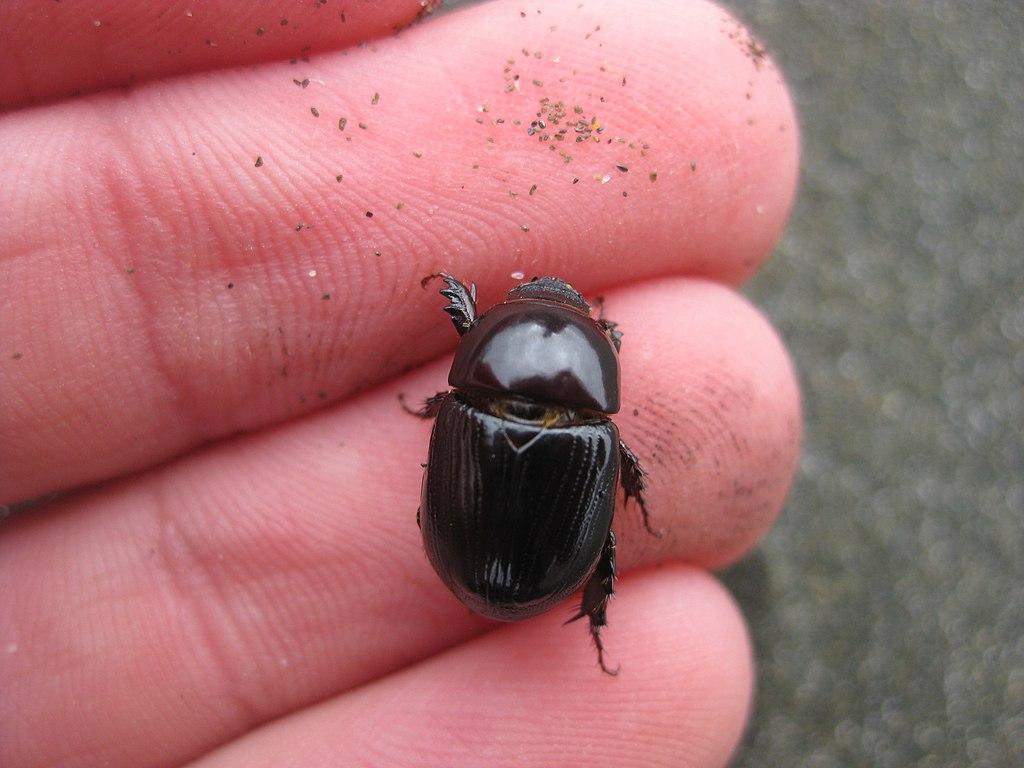
African black beetles have unusually shiny black bodies
The African black beetle is also known as the black lawn beetle. This insect is known to damage and destroy lawns and other turfs, especially during the summer. Unlike other beetles, such as the adult black carpet beetles who feed on pollen and adult furniture beetles who do not feed at all, the adults of African black beetles can be severe pests just like their larval stages.
The adult African black beetles are also very important in the agricultural economy. They attack and destroy a number of vegetable crops as well as grapevines and many types of ornamental plants. Their larvae can also damage crops but are not as harmful as the adults. Larvae usually spend their time below the soil, often creating small soil mounds.
There are a number of biological and chemical pest control options available for these insects. But it would help if you talked to an expert before using any option, as pest control in the case of African black beetles is not the easiest thing to do.
African Black Beetle Quick Facts And Identification Guide
| Scientific name | Heteronychus arator |
| Size (average) | Almost half an inch long (10 to 15 mm) |
| Color | Shiny black |
| Body features | – Oval or Capsule like body – No antenna – Short legs – Legs might have short brown hair – Wing covers have light longitudinal striations |
| Flying | Yes |
| Range and Habitat | – Native to Africa – Introduced and widespread in Australia and New Zealand – Common in the wetter coastal regions. |
4. Black Vine Weevils

A black vine beetle has yellow or gray spots on its back
Also known as the taxus weevil, the black vine weevil feeds on a wide range of ornamental plants. It is very harmful to hemlock and many other broad-leaved evergreens in its larval stage. However, in its adult stage, its hosts include a broad range of deciduous and herbaceous plants.
Adult black vine weevils are known to feed on more than 100 different kinds of plants. However, they prefer yews and rhododendrons. Their life cycle begins as larvae in the soil, and these larvae can even cause the death of infested plants. The plants that survive often show stunted growth because the larvae keep feeding on root saps.
The pest control efforts for taxus weevils can be targeted at adults as they first emerge on favored host plants. Try to examine host plants between May and June for feeding damage. Take care in spraying the pesticides thoroughly over the plants as well as over the soil because it is where the weevils hide during the day.
Black Vine Weevils Quick Facts And Identification Guide
| Scientific name | Otiorhynchus sulcatus |
| Size (average) | Around half an inch long (10 to 12 mm long) |
| Color | Blackish brown |
| Body features | – Long oblong oval shaped – Light yellow or gray spotting on back – A broad snout – Bumpy thorax and wing covers |
| Flying | No |
| Range and Habitat | – Native to Europe but common in North America as well |
5. Rhinoceros Beetles
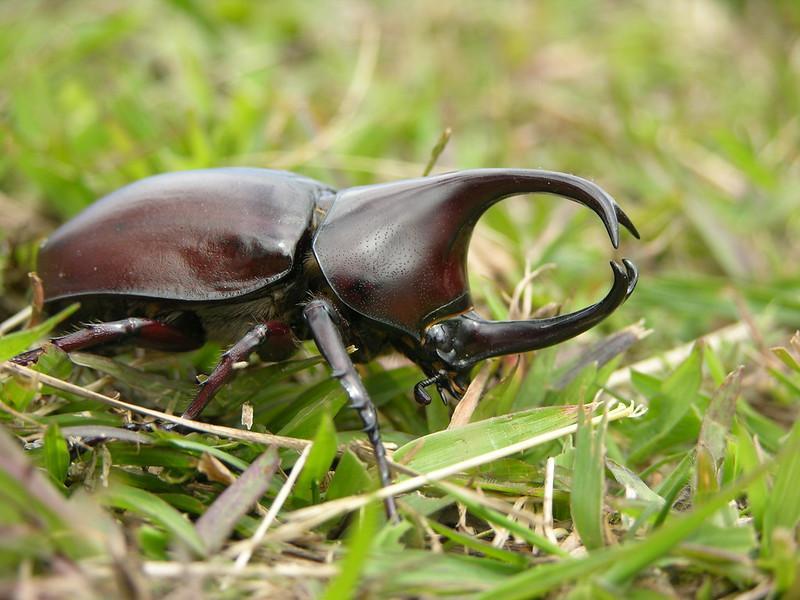
Some rhinoceros beetles have been reported to lift up to 850 times their own weight
Rhinoceros beetles are not a species but a group of some of the largest beetles on earth. They get their name from the characteristic large cephalic horn. They are also sometimes called Hercules beetles because of their immense strength.
Despite their colossal sizes, these magnificent insects are entirely herbivorous. Also, there is no need to be afraid of these giant beasts; they are totally harmless. They cannot sting or bite. They have a large horn, but it is not used for attack or defense but for occasional fights with other beetles to win a feeding site.
Moreover, rhinoceros beetles are not the greatest pest beetles. However, they can still cause significant damage to tree plantations if present in enough numbers. You will also be surprised to know that despite their size, these beetles can fly and they are very strongly attracted to lights at night.
Rhinoceros Beetle Quick Facts And Identification Guide
| Scientific name | Subfamily Dynastinae contains around 2500 species |
| Other names | Horn beetles, Hercules beetles, Unicorn beetles |
| Size (average) | Up to 15 cm in length |
| Color | Usually glossy blue-black |
| Body features | – A thick hard exoskeleton – A protruding horn – Cylindrical fat body |
| Flying | Yes |
| Range and Habitat | – Distributed throughout the world – They live in gardens, woodlands, farmlands, plantations, etc. |
6. American Oil Beetles

American oil beetles, when disturbed, secrete an oily secretion that can cause blister formation on human skin
These beetles get their name from the oily secretions they release when they are disturbed or threatened. This secretion contains a cantharidin chemical, which can cause skin irritation and blister formation in humans. This is why these beetles are also known as blister beetles. Adult beetles are slow-moving, and they can be found in grass and around plants they eat, such as buttercups.
These beetles can occasionally become pests and destroy field crops such as potatoes and tomatoes. If you find one of these in your home or garden, wear protective gloves while removing it. In the case of many beetles, you can use an insecticide that is certified for home use.
American Oil Beetle Quick Facts And Identification Guide
| Scientific name | Meloe americanus |
| Other names | American blister beetle |
| Size (average) | 3 to 4 cm long |
| Color | Black with some green hues |
| Body features | – Bumpy body – Upside down L-shaped antennae on the head – Long spindly legs – Large abdomen when compared to head and thorax |
| Flying | No |
| Range and Habitat | – Found throughout the United States – They usually prefer grass-covered areas |
7. Black And Red Blister Beetles
Black and red blister beetles are known for causing extreme pain to unaware handlers who do not know what this black beetle is capable of. Like American oil beetles, they also release an oily secretion from their body containing cantharidin. This can cause severe itching and blister formation on human skin.
Little is known about black, and red blister beetles’ life cycle and behavior, and more research needs to be published. They are known to parasitize the eggs of grasshoppers. Because of its unique body shape and coloring pattern, some people also call it the armadillo of insects.
Black and Red Blister Beetle Quick Facts And Identification Guide
| Scientific name | Megetra cancellata |
| Size (average) | 10 to 15 mm in length |
| Color | Shiny black with red stripes and dots |
| Body features | – A tear-shaped body – Reduced wings – Large, spindly legs |
| Flying | No |
| Range and Habitat | Found in Central and North America |
Cedar Beetles
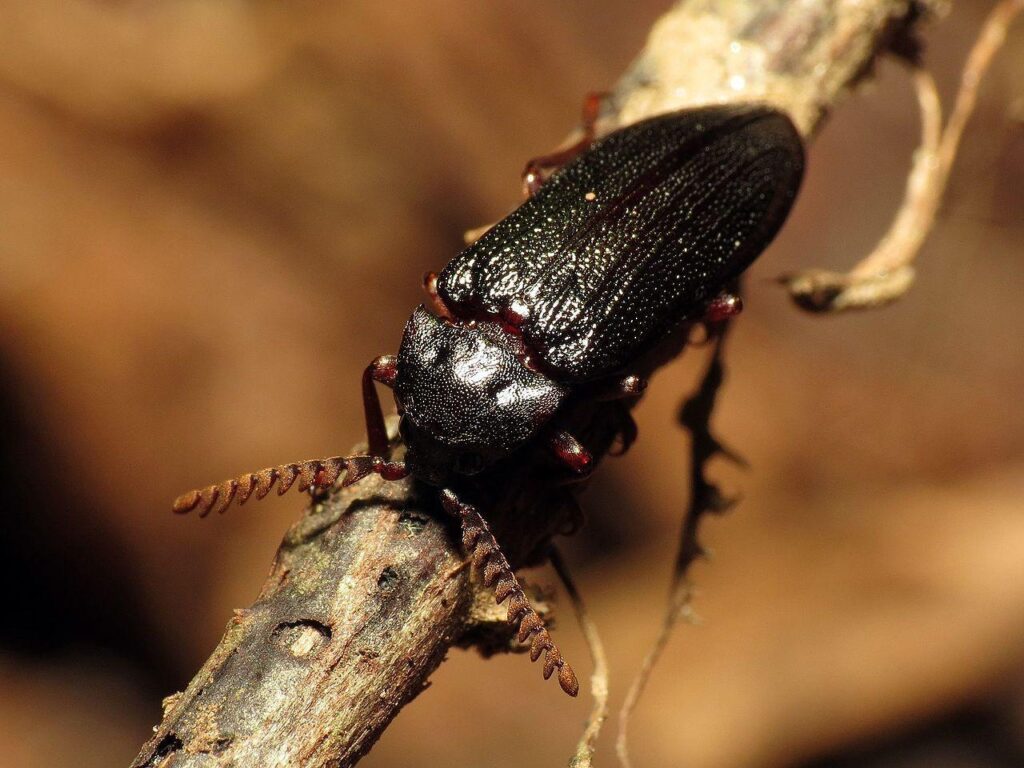
Cedar beetles are usually found crawling and flying around elm trees
Also known as cicada parasite beetles, cedar beetles, despite their vast numbers, are not considered pests. In fact, some people argue that these insects should be regarded as beneficial as they keep the populations of cicadas in check.
These beetles can be found in huge numbers around trees. Also, female beetles lay their eggs on trees which leads to some people thinking that they are attacking trees which is not the case.
Although both females and males can fly, female cedar beetles usually lie around the elm trees, and it is the males that actively fly around. Flies and wasps are common predators of cedar beetles.
Cedar Beetle Quick Facts And Identification Guide
| Scientific name | Sandalus niger |
| Size (average) | 2 to 5 mm in length |
| Color | Shiny black or reddish-black |
| Body features | – Long oblong bodies – Orange colored abdomen – Narrow heads with prominent antenna – Triangular thorax |
| Flying | Yes |
| Range and Habitat | – Found in North America – Habitats include woodlands, forests, and where their tree hosts are present |
8. Black Stink Beetles
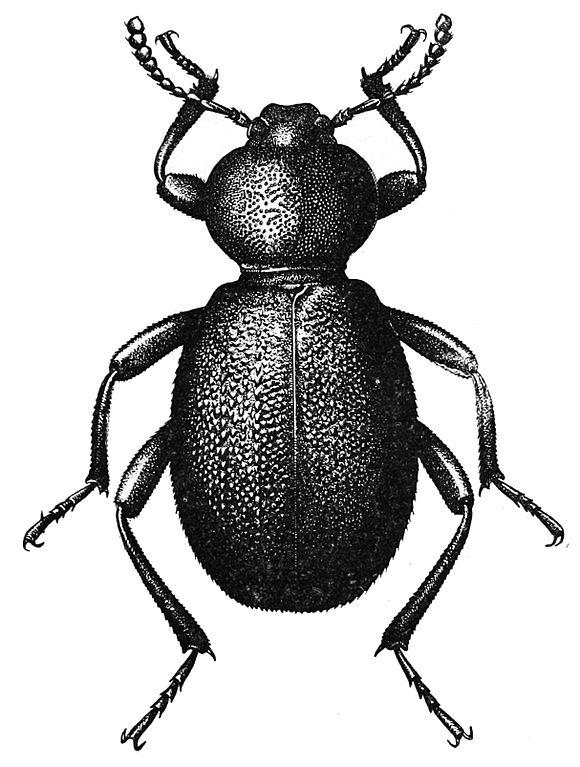
A black stink beetle emits a smelly secretion from its rear end when disturbed
These beetles are also known as pinacate beetles or darkling beetles. When they are disturbed, they stand on their heads and assume a defensive posture which is why some people also refer to them as clown beetles. Also, these beetles secrete a foul-smelling secretion from their rear end when threatened.
Stink beetles are different from stink bugs. You can look at the table at the start of this article to learn about the differences between a beetle and a bug. Stink beetles primarily eat decayed organic matter on grasses, plants, and other decaying vegetation. Stink beetles can survive for long times without water. This is because they meet all their water requirements from their food
Black Stink Beetle Quick Facts And Identification Guide
| Scientific name | Genus Eleodes |
| Size (average) | 25 to 35 mm in length |
| Color | Dark brown or jet black |
| Body features | – Oval or oblong body with a tapered end – Front end of the body is lowered, while the rear end is raised – Smooth looking or rough, depending on the species |
| Flying | No |
| Range and Habitat | – Endemic to western North America – Found in shrubs, mountains, and open dunes – Found under logs or detritus |
9. Hermit Flower Beetles
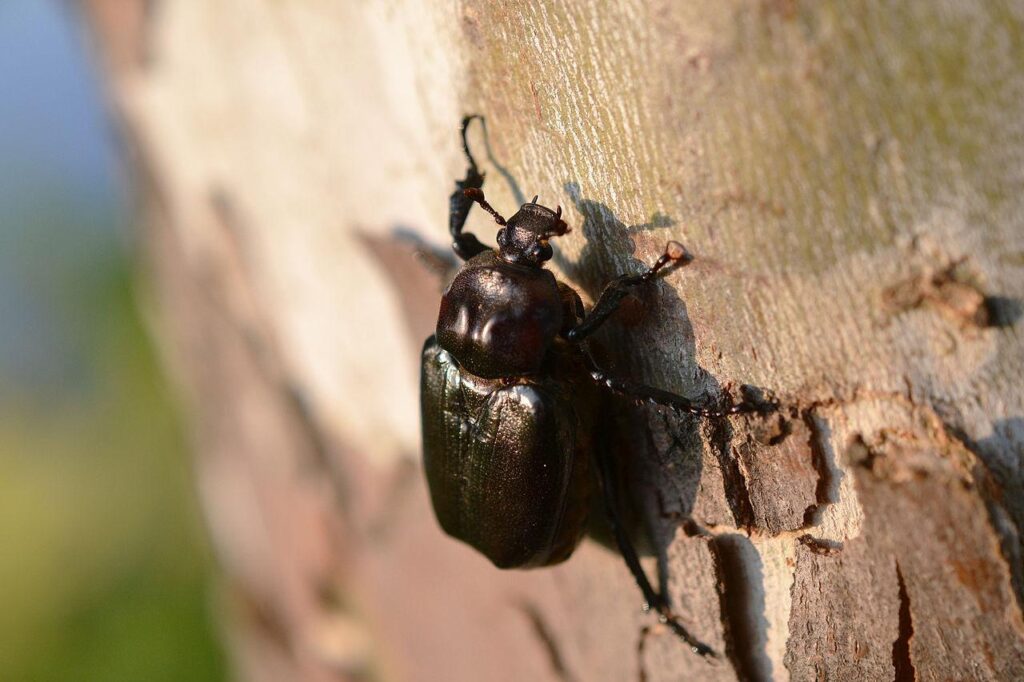
A hermit flower beetle emits an intense leathery smell when disturbed
They are a type of scarab beetle and can be found in wooded areas around tree trunks. They are said to give off a characteristic leathery smell when approached or disturbed. These insects like to remain unnoticed, and adults can be seen visiting the flowers from time to time.
They are nocturnal and reside near the bases of trees during the daytime. The larvae of hermit flower beetles reside deep inside dead or rotting wood and tree logs which are often apple or cherry trees. They do not harm the healthy trees and only use decaying wood, thus helping return the nutrients back to the soil.
Hermit Flower Beetle Quick Facts And Identification Guide
| Scientific name | Osmoderma eremicola |
| Size (average) | 21 to 31 mm in length |
| Color | Shiny black or dark brown |
| Body features | – Shiny hard shell – A dimple on the thorax, right between the eyes – A smooth elytra with faint lines – Short brown hair on the lower abdomen |
| Flying | Yes |
| Range and Habitat | – Found in southern Canada and the United States – They are fond of rotten logs in woodlands and orchards – Adults are nocturnal and attracted to lights |
10. Pigweed Flea Beetles
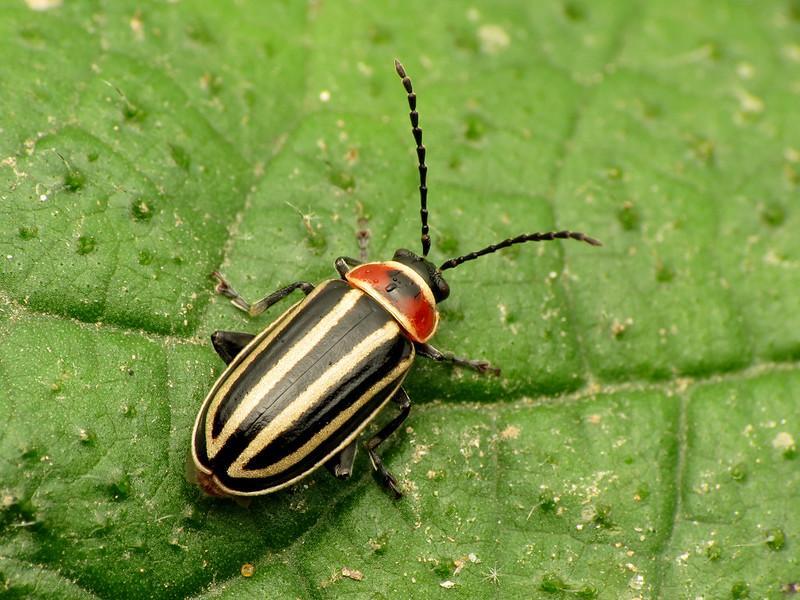
Pigweed flea beetles feed on pigweeds which are considered serious agricultural pests
They are called pigweed beetles because they eat on a group of plants that were and still are used to feed pigs (Amaranth family). They are active from late spring to autumn. Although they are not significant pests, they can still cause issues if present in substantial numbers.
In Virginia, USA, these beetles are minor pests of spinach, beets, and swiss chard. Adult pigweed flea beetles can be seen feeding on plant foliage. They chew small round holes in the leaves. The pigweed flea beetles are often confused with pale-striped flea beetles and three-lined potato beetles.
Since pigweeds are considered serious agricultural pests, the pigweed flea beetles are also regarded as beneficial insects as they keep pigweed plants under control.
Pigweed Flea Beetle Quick Facts And Identification Guide
| Scientific name | Pigweed Flea Beetles |
| Size (average) | Around 5 mm in length |
| Color | Black with red and white markings |
| Body features | – A reddish black head – Wing covers have yellow or white lines on them – Legs are red and black – Underside of the body is usually yellow – Overall, a banded appearance |
| Flying | Yes |
| Range and Habitat | – Found throughout the United States and Canada – They have also been spotted in Mexico – Prefer living in agricultural areas |
11. Cucumber Beetles
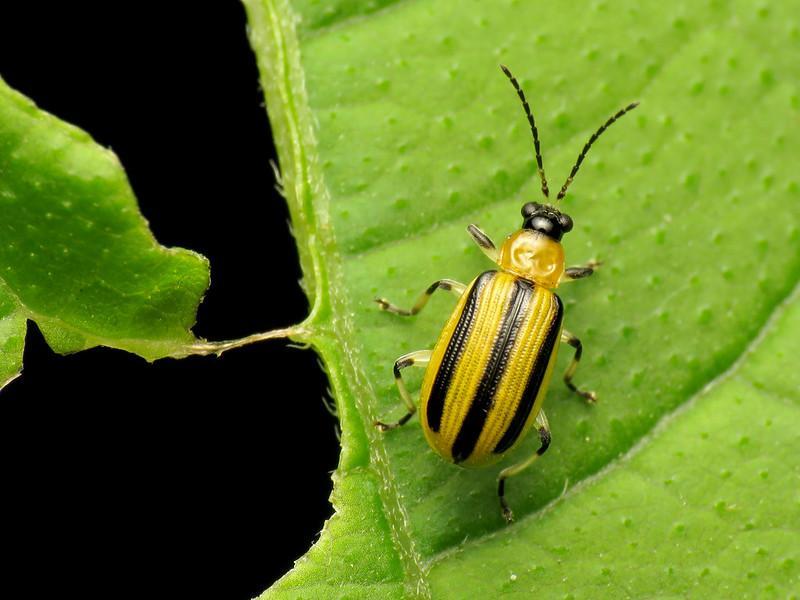
A striped cucumber beetle
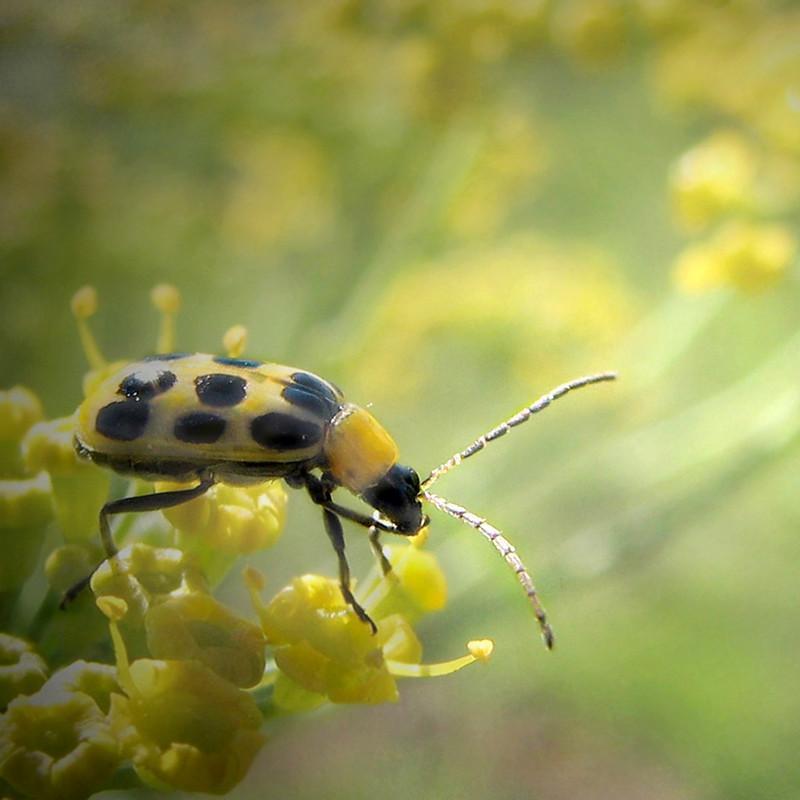
A spotted cucumber beetle
Cucumber beetles are common pests of vine crops such as squash, pumpkin, watermelon, and as their name suggests, cucumber. These beetles can cause severe damage to flowers, leaves, and roots. They also interfere with pollination, which could lead to reduced fruit sets.
They can also carry bacterial pathogens that can cause wilting of cucurbits (cucumbers, melons, squash, etc.), ultimately killing them. Cucumber beetles become active between May and June. These insects have a lifespan of around eight weeks, during which both larvae and adults feed on plants.
To control a cucumber beetle infestation, pay special attention to any weeds growing in your garden. These can act as hosts for cucumber beetles. Also, keep your garden clean of debris and leaf litter so these beetles cannot hide for overwintering.
Cucumber Beetles Quick Facts And Identification Guide
| Scientific name | Acalymma vittatum (The Striped cucumber beetle) Diabrotica undecimpunctata (The Spotted cucumber beetle) |
| Size (average) | Around 5 mm in length |
| Color | Black and Yellow |
| Body features | – Longitudinal dark stripes or dots on the body – Black abdomens |
| Flying | No |
| Range and Habitat | – Indigenous to North America – Also found in Mexico and north into southern Canada |
12. Red-Lined Carrion Beetles

Red-lined carrion beetles are nocturnal creatures that often gather around lights
Red-Lined Carrion Beetle has a very unusual diet. It can be found feeding on maggots that cover rotting carcasses. It is also very foul-smelling, which is thought to be an adaptation for protecting it from predators. Red-Lined Carrion Beetles are attracted to light during the night and may congregate in well-lit places.
They are significant decomposers of carrions and seem to prefer bird carcasses more than anything else. However, their larvae can also appear on human corpses to feed on fly larvae.
Red-Lined Carrion Beetle Quick Facts And Identification Guide
| Scientific name | Necrodes surinamensis |
| Size (average) | 12 to 25 mm in length |
| Color | Dark black |
| Body features | – Body has raised ridges on it – Elytra is very rigid – Orange markings on the body |
| Flying | Yes |
| Range and Habitat | – Found in North America |
13. White-Spotted Sawyer Beetles
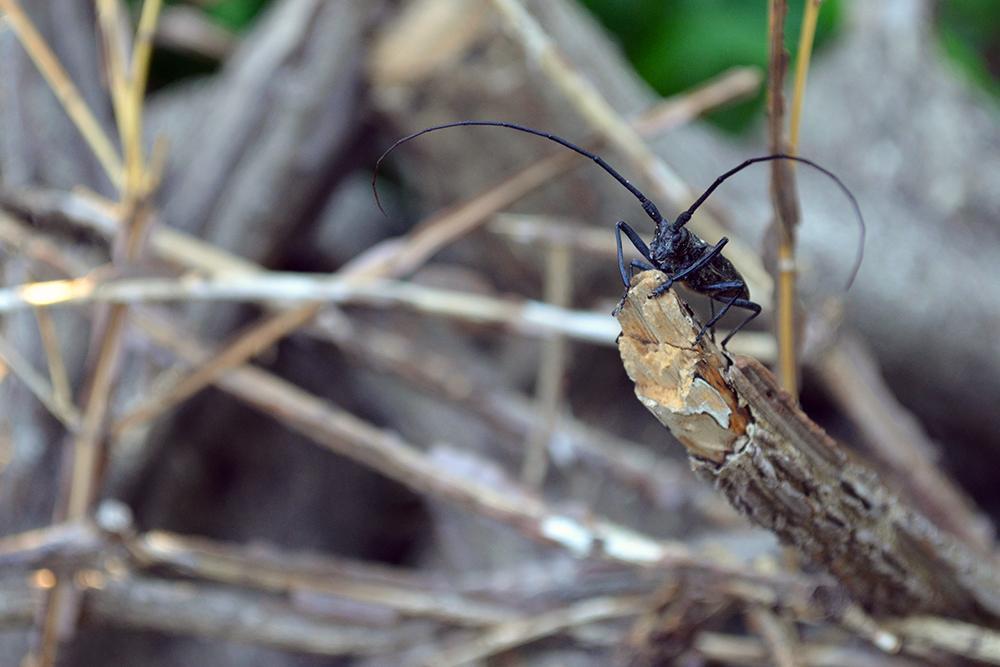
A white-spotted sawyer beetle has an unusually long antenna, reaching nearly three times its own body size
White-Spotted Sawyer Beetle is a common wood boring insect. These beetles are primarily minor pests of some coniferous trees such as balsam fir, white pine, and species of spruce. However, the beetle is not really harmful to trees as it tends to attack already weakened and dead or decaying plants. For this reason, these beetles are also known as secondary pests.
Like most of the beetles on our list, sawyer beetles are also most damaging to the plants during their larval stages. Adults usually only cause minor plant injuries. These beetles are also typically regarded as ecologically significant. By feeding on the dead and decaying trees, they help nutrients return to the soil.
White-Spotted Sawyer Beetle Quick Facts And Identification Guide
| Scientific name | Monochamus scutellatus |
| Other names | Spruce sawyer, Source bug |
| Size (average) | Around 25 mm in length |
| Color | Jet black |
| Body features | – Unusually long antenna, reaching lengths of up to 75 mm – A white speckle on the wing covers – A protrusion on each side of the collar |
| Flying | Yes |
| Range and Habitat | – Native to and found throughout North America – Usually found in boreal forests |
14. Black fireflies

A black firefly uses pheromones to communicate instead of light like its other relatives
The black firefly has entirely dark elytra or wing covering compared to other fireflies. Also, unlike other species of firefly, the black firefly does not use its light organ during adulthood. However, they have been seen to use the light after emerging from the pupa.
Black fireflies use pheromones to communicate with the nearby members of their species. Adult fireflies also do not eat, despite having chewing mouthparts. They can often be seen on or nearby milkweed plants. The milkweed plant might act as a deterrent to its predators.
Black firefly Quick Facts And Identification Guide
| Scientific name | Lucidota atra |
| Size (average) | Up to 10 mm in length |
| Color | Jet black |
| Body features | – A completely black elytra – Yellow near shoulders – A reddish head – Unusually long antennae when compared to body size – A large black spot on the head with red borders |
| Flying | Yes |
| Range and Habitat | – Found in central and north America – Prefer living in moist and humid places |
Frequently Asked Questions
How do you get rid of black beetles?
The first thing you must do in order to get rid of black beetles is to locate all the items that have been infested. Then, discard all the infested items immediately as it will prevent the beetle populations from spreading further.
Different types of black beetles have different hiding places. For example, some of them hide in food storage places, others hide in small crevices, and some types even might be lurking in your bedsheets. So, you will also have to identify the type of beetle that you are dealing with to take further measures.
You can check the guide above to learn about different kinds of black beetles and specific treatment methods for each type.
Are black beetles harmful?
It all comes down to the type of black beetle that you are talking about. Some of them are serious agricultural pests. Others can cause severe skin irritation or blister formation on the touch. However, black beetles are not generally harmful to humans. Despite having chewing mouthparts, they do not bite unless provoked. So, there is no need to be afraid of them, but you might still want to keep their numbers in check.
Are black beetles good?
Some types of black beetles are considered beneficial for the environment overall. For instance, the White-Spotted Sawyer Beetles and Pigweed Flea Beetles. These beetles feed on dead or decaying wood or some serious agricultural weeds. Thus, they help return the nutrients back to the soil and keep the number of agricultural weeds in check.
However, some black beetles can become severe pests if present in large numbers. You can read all about them in our guide above.
Source For Further Reading
- Black beetles | Extension Entomology. (2017). Retrieved 29 March 2022, from https://blogs.k-state.edu/kansasbugs/tag/black-beetles/
- Ground beetles. (2022). Retrieved 29 March 2022, from https://extension.umn.edu/nuisance-insects/ground-beetles
- African black beetle in horticulture | Agriculture, and food. (2022). Retrieved 29 March 2022, from https://www.agric.wa.gov.au/olives/african-black-beetle-horticulture?nopaging=1
Aside from black beetles learn more about different types of plant bugs:
Black Caterpillar Types: How to Identify Common Species, Fun Facts and More!
Aphids on Indoor Houseplants: 10+ Smart Ways to Get Rid of Them!
Root Maggots: How to Get Rid of Root Eating Insect Pest Naturally?







